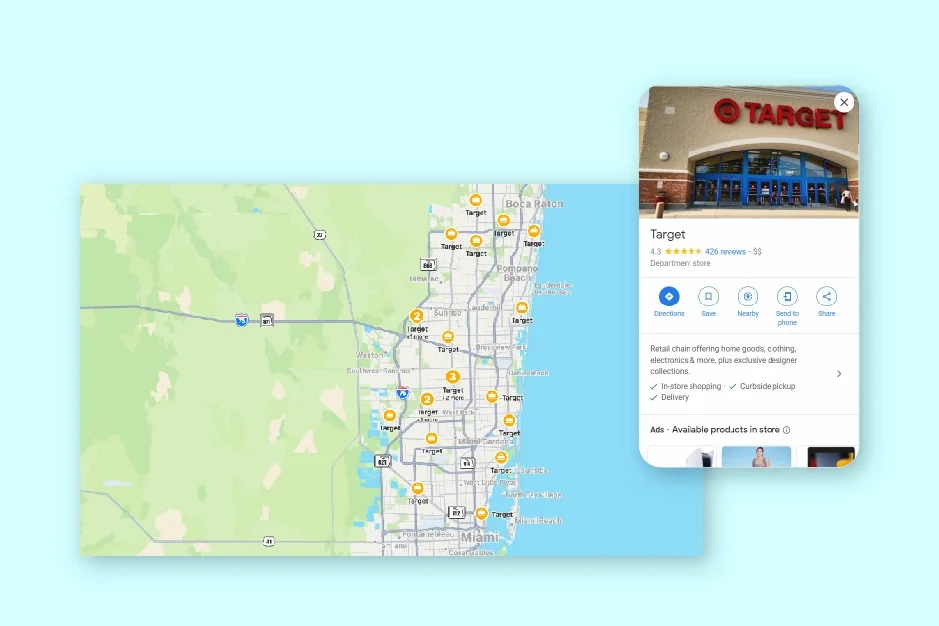
Remember way back when Google Analytics (or another site analytics tool) gave you a pretty decent look at how customers were interacting with your brand? Long gone are those days when a consumer’s path to purchase started with a search that drove a person to your website to consider the information there and make a decision.
Today, the vast majority of interactions happen outside of your own online properties—in fact, a customer may never visit your site at all. In our research, we’ve found that just 1 in 60 local search (Map Pack) views results in a click to visit the company’s website.
What’s changed?
Over the last decade, Google has pulled more and more business information into dynamic search results. Customers can see your store hours, address and map location, local reviews, and more all without ever leaving the search results page. A searcher can click to call or get driving directions, see photos and menus, and otherwise gather the information they need to get to your doorstep without ever interacting with you or your team.
“Google is your new home page. For many businesses, it has become the single most important internet presence in terms of attracting new customers.” – Mike Blumenthal
Google is not content to simply provide local business information, though.
The world’s largest search engine (with over 93% of mobile search market share) wants to not only facilitate the transactions that drive local business but to actually become a transactional layer between businesses and the customers they serve. In that regard, Google is already well on its way.
This isn’t a new concept for Google.
When Google launched Flight Search back in 2011, it put the search engine in direct competition with some of its own customers on the advertising side of the business. While Kayak and Orbitz were paying Google to drive paid traffic to their sites, Google was providing virtually the same service right on the search results page. In 2012, Google+ Local launched with integrated Zagat reviews for local restaurants and by 2015, you could book a hotel from Google search results.
Google’s tradition of acquiring the companies, tools, and teams needed to expand its transactional strategy is going strong (despite recurring accusations of antitrust over the years). Its acquisition of the.ordering.app late last year, which enables online ordering from food service businesses right from search, is just one such example.
Formats have changed, new verticals have been penetrated and features have been updated over the years but the underlying principle is the same.
Google has added a transactional layer to search that positions its own business firmly between other companies and the customers they serve.
Now, service businesses like the ‘Consider It Done’ barbershop location in Philadelphia can have people book appointments directly within the Search or Maps experience:

Google is dipping its toe into the healthcare space, as well, with telehealth links. In the near future, we anticipate that we will likely see patients booking their healthcare appointments directly through Google.
In retail, Google opened up product listings this spring—paying for ads will get you higher positioning but anyone with a website or a marketplace store can now list their products in search for free. Bill Ready, Google’s president of commerce, told Verge at the time, “We think that by doing this, it helps many more shoppers find what they’re looking for, but it also helps bring some quite needed relief to the retail and small business ecosystem.”
It doesn’t cost the business anything extra to have this functionality in search. But is it altruism on Google’s part? When businesses can offer booking right on their local listing, you can bet competitors are going to sit up and take notice. Appearing higher and more often in local searches—whether organically or via paid advertising—is even more important.
Already, advertisers can pay for promotion inside another local listing, as with DoorDash’s delivery service on this Applebee’s result:
As local search expert Mike Blumenthal says, Google is the new homepage and has become the single most important element for attracting new customers online. As Google furthers its strategy of being the transactional layer of the web, brands need to factor this aspect of each locations’ online visibility into their marketing plans. Ask yourself:
- Are you aware of which competitors are using transactional elements in their local listings?
- How do you rank in local search in each location for your target keywords?
- What opportunities do you have to make booking, ordering online or otherwise transacting with your business easier for searchers?
- Are your paid and organic strategies working together to ensure even coverage and reduce paid search waste?
- How can you entice existing customers to book directly with you?
Get a free local audit today to see how your locations measure up against their local competition.
